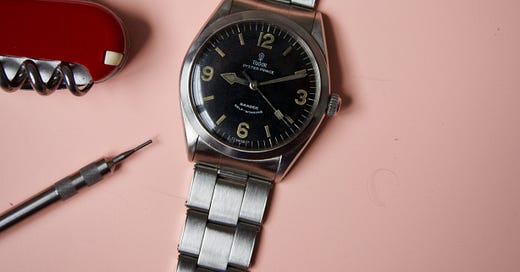For Your Reference: Tudor Ranger
[Some photos and text have been edited out of the newsletter so that it is more friendly to your inbox. Head to the link above for the full article. Also, the full article is about 4.3k words, so if you don’t care that much about the Ranger just scroll through the photos and bookmark the reference table at the end.]

There is nothing particularly special about the Tudor Ranger. It didn’t accompany adventurers to Mount Everest or Antarctica. Even the name, “Ranger”, evokes less audacious feats than Explorer or Submariner — perhaps conjuring more benign images with words like “Power”, “National Park”, or “Walker, Texas” preceding it.
But, the Tudor Ranger — this unassuming, 34mm watch — has long beguiled collectors. It’s even been called “the most faked vintage watch” around, prompting some to give blanket advice not to even attempt to acquire one for risk of ending up with a fake or a frankenwatch that’s been put together. This has always struck me as unfortunate: the internet has unlocked an entire world of watch collecting and information sharing, but for some reason the Tudor Ranger has remained an enigma, devoid of a comprehensive cataloging.
Even with the surge in popularity of the Rolex Explorer reference 1016, and smaller vintage watches generally, there has not been a compilation of the Tudor Ranger and its various iterations. In broad strokes, it’s similar to the Explorer: black dial, 3-6-9 Arabic numerals (“Explorer dial”), stainless steel case, and produced from the 1960s through the 1980s. But the Ranger measures 2mm smaller than the vintage Explorer. Additionally, you’ll find date and no-date iterations of the Ranger. And while the Explorer had its own, single reference throughout this time period, the Ranger can be found in a number of references, all with slightly varying traits.
What is the Tudor Ranger?
In between the lugs on either side of the case, Rolex and Tudor typically engrave the reference number and the serial number of the watch, giving collectors much of the information they need regarding a watch’s model and production date. Herein lies the beginning of the difficulty: the Tudor Ranger isn’t a specific reference as much as it is a configuration of a Tudor Oyster, put together in Geneva. Throughout the 1960s and 1970s, Tudor Rangers were produced in the same case reference numbers as typical Tudor Oysters, Oyster Princes and Oysterdates.
That is to say, the Tudor Ranger is a 34mm Tudor Oyster with a matte black dial featuring Arabic numerals at 3-6-9-12, a distinctive shovel hour hand, ETA caliber, and Rolex-signed crown, offered on an Oyster-type bracelet.
Thus, to understand the Ranger, it is also important to understand the Tudor Oyster line to discern whether a particular Ranger is correct and original. Not until the 1980s, with the introduction of the 90000 series, did the Tudor Ranger receive its own case reference number.
With Tudor giving the Ranger its own reference numbers later in the model’s production run, the Ranger thus divides neatly into two “series”, which I’ll call the “Early Series” and “Late Series”. The Early Series are those Rangers produced through the 1960s and 1970s that share references with the standard Tudor Oysters and Oyster-Princes of the day, corresponding with references 79xx. The Late Series are the 90000 series of Rangers produced during the 1980s.
A Word on Red Rangers Much of the caution in relation to Rangers comes from the torrent of “Red Rangers” you’ll find with a simple search. Despite a forum legend that someone, somewhere may have had a legitimate Red Ranger and had it serviced by a Rolex Service Center, all Red Rangers are regarded as fake dials.
Tudor Ranger: Origins
Hans Wilsdorf, the founder of Rolex, took over the Tudor trademarks to form the company Montres Tudor in 1946. The goal was to stick off-the-shelf (i.e. ETA) movements into the famous patented Rolex Oyster cases (and throw on the coronet’s bracelet, crown, etc. for good measure), creating a cheaper product for the mass market. In 1952, Tudor launched the Oyster Prince line, using Rolex’s proprietary automatic rotor. The Early Series Tudor Ranger is essentially a configuration of the Oyster and Oyster Prince lines.
The first step in analyzing whether any example of a Ranger is correct is understanding if the reference makes sense, Ranger or not. Here, it’s first helpful to understand some of Tudor’s dial nomenclature: Prince signifies an automatic caliber. An Oyster-only dial then signifies a manual caliber, while Oysterdate signifies a date complication. Throughout the 1960s and 1970s, Tudor Oysters, Oyster-Princes, and Oysterdates were produced in a number of references and configurations.
Ranger examples should correspond to the references of a typical Tudor Oyster or Oyster Prince model, with matching signature and text on the dial. Common early Tudor Oyster case references that can feature Ranger configurations include:
Reference 7965, 7995: Oyster Prince (automatic, time only)
Reference 7966, 7996: Prince Oysterdate (automatic, date complication)
Reference 7984, 7991: Oyster (manual, time only)
Reference 9050: Prince Oysterdate (automatic, date complication)
For instance, a Tudor Oyster-Prince reference 7995 is an automatic, time-only model, whether or not it is a Ranger. Another common Ranger reference, 9050, is a Prince Oysterdate model. You should never find, for example, a date complication in a 7995 case, or a time-only caliber in a 9050. This rule applies for Ranger and non-Ranger examples alike.
Unlike with the Submariner or the brand’s chronographs, the Tudor website makes scant mention of the history of the Ranger, offering just this:
The Tudor Oyster Prince Ranger model was introduced in the 1960s and was first listed in the catalogue in 1969. It remained in the catalogue until 1988. The model presented here (reference 7995/0) [Ed. note: see images below] dates from 1967 and has a 34 mm waterproof steel case. Its matte black dial with the rose logo is punctuated with luminous rectangular hour markers and luminous Arabic numerals at 3, 6, 9 and 12 o’clock. Its characteristically shaped hands also feature luminous material. Its self-winding movement is the ETA calibre 2483 with the signature “Tudor Auto-Prince” on the rotor. The steel Oyster-type bracelet (reference 7835) has folding links and a Rolex signed clasp.
Tudor is non-committal as to the exact year when the Ranger was introduced, but we first see it appear in catalogues in 1969. It also seems likely it wouldn’t have been introduced before the Rolex Explorer came into its own with the release of the Reference 1016 in the early 1960s.
Tudor Ranger: Early Series
These early years are where much of the confusion regarding the vintage Tudor Ranger lies. In addition to the confusion that various reference numbers present, the Ranger underwent a couple noticeable changes: the brand’s logo transitioned from a rose to a shield, and the minute hand changed from a flared style to a pencil hand.
In Isnardi’s Tudor Anthology, the author dismisses all rose Rangers as fake. This is emphatically not the case, as dozens of verifiably correct and original rose Rangers have been found (and, as discussed above, Tudor itself has verified a rose Ranger as the inspiration for its modern Heritage Ranger). However, because the Ranger did not begin to appear in Tudor catalogues until 1969, by which time the brand had begun to transition from its rose logo to the shield logo, there has been confusion.
Like with other Tudor models, the move from the rose to the shield logo can be observed in examples dating to a few years before Tudor “officially” switched to the shield logo in 1969. For serial numbers in this time period (around the late 1960s), either a rose or shield logo might be correct. With the introduction of the shield logo, Tudor also moved away from the “medieval” styling of the Tudor name that’s seen accompanying the rose logo, favoring instead a simple, serif font.
Throughout its production, the hour hand of the Tudor Ranger is a distinct shovel hand. Much the way the snowflake hand eventually sets the Tudor Submariner apart from its Rolex analog, the shovel gives the Ranger a character distinct from that of the Explorer. Similarly, the central seconds hand features a large rectangle of lume towards its tip on all examples of the Ranger. There is some variation in the minute hand: typically, you’ll find a pencil-style hand, similar to that found in an Explorer or Submariner. But in early examples, a flared minute hand can also be found (also referred to as a “Mark 1” minute hand). Nowadays, it’s difficult to find these in completely original condition: lume falls out of the broad flare and is replaced, or the hand is replaced entirely.
These Mark 1 hands are only correct on very early examples of the Ranger, until about the mid-1960s. On examples below, note how this hand extends just to the beginning of the chapter ring’s hashes: many incorrect or fake flared minute hands will look too big for the watch, extending farther, often featuring a wider flare. Typically, they’ll be paired with an hour hand that is also incorrect, often with a longer base and with lume that continues farther up that base.
Being introduced around 1963, the Ranger exists during a time when Rolex and Tudor began to use tritium lume. You’ll find all examples of the Ranger thus feature tritium lume, with “T Swiss T” printed below 6 o’clock indicative of this luminous material.
Finally, the varying bracelet suppliers for Rolex and Tudor during the period in which these Early Series Rangers were produced mean that a number of bracelets could feasibly be “correct” for any particular example. Most commonly, the Ranger will be found on an Oyster-style reference 7835 bracelet, given the Ranger’s 19mm lug width.
These are some of the common and transitional elements of Early Series Rangers; now, let’s take a look at the specifics of each reference. The Early Series references are organized below as follows: (1) automatic, no-date references, (2) automatic, date references, (3) manual, no-date references.
Ranger Reference 7965
AUTOMATIC, NO DATE
Chronologically, the first time we see the Tudor Ranger appear is as Reference 7965. it’s an Oyster-Prince, powered by an automatic Tudor caliber 2483. It’s a reliable 25-jewel ETA movement that you’d expect to find across Tudor’s lines at the time. The earliest Ranger example I have found is a Reference 7965, with a serial number dating it to 1963 (above).
A correct Reference 7965 will feature the Tudor rose logo, with the hyphenated word Oyster-Prince printed underneath. Above 6 o’clock are the words Ranger and the “smiling” Self-Winding printed below. Note the pairing of Oyster-Prince with Self-Winding here: in Late Series automatic examples (discussed below), the self-winding text is not present; thus, an automatic 7900 series Ranger with no such smiling text may be an initial tip-off of a put-together watch using one of these later dials.
The Reference 7965 is an example where it is possible to find an original flared minute hand. With production spanning to 1966, later examples feature a pencil hand.
The font of each line should be a primary point of analysis in evaluating any example of a Ranger. The font at 6 o’clock in these early examples is particularly distinctive, revealing small serifs upon close inspection.
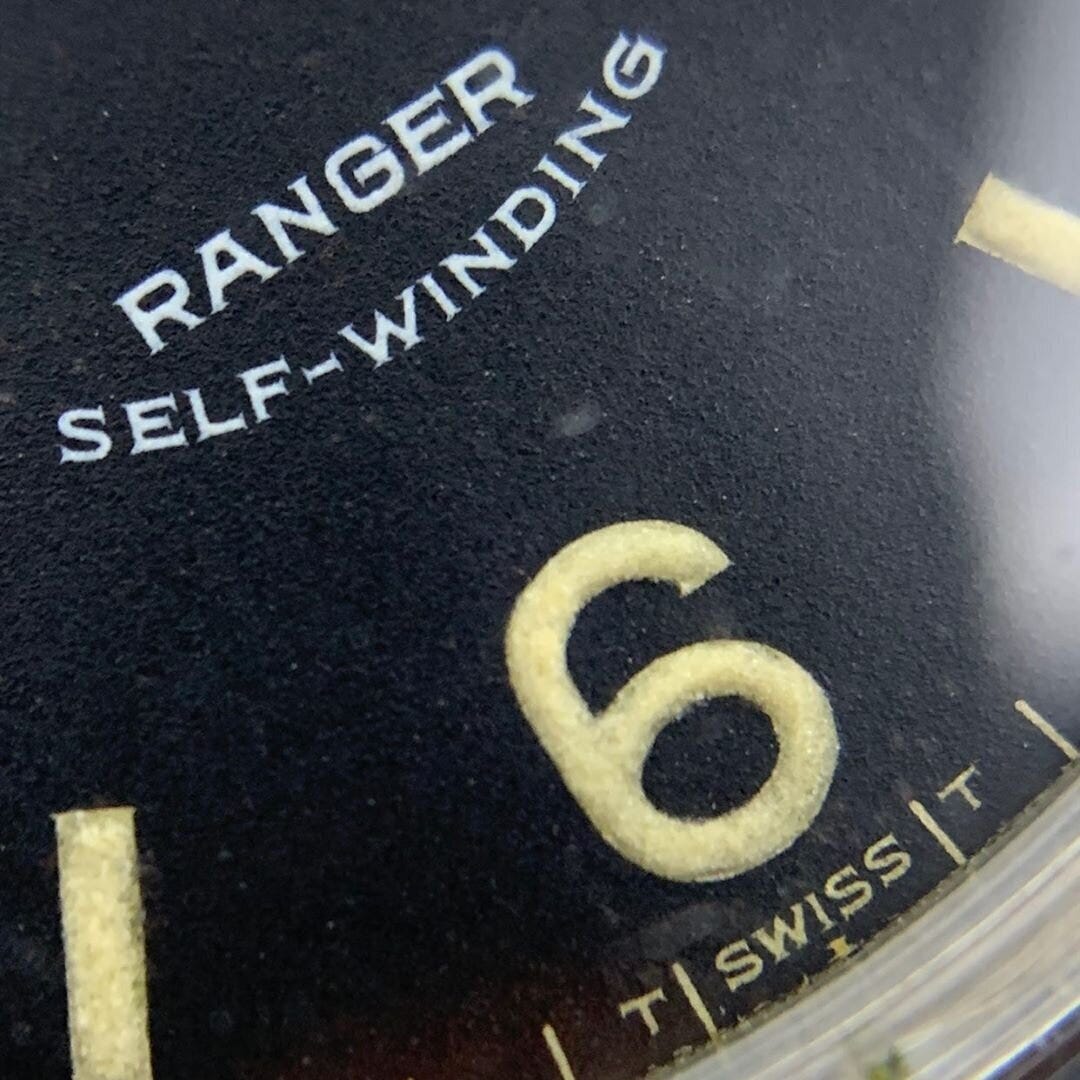
Photo courtesy of @mkrlx
Ranger Reference 7995
AUTOMATIC, NO DATE
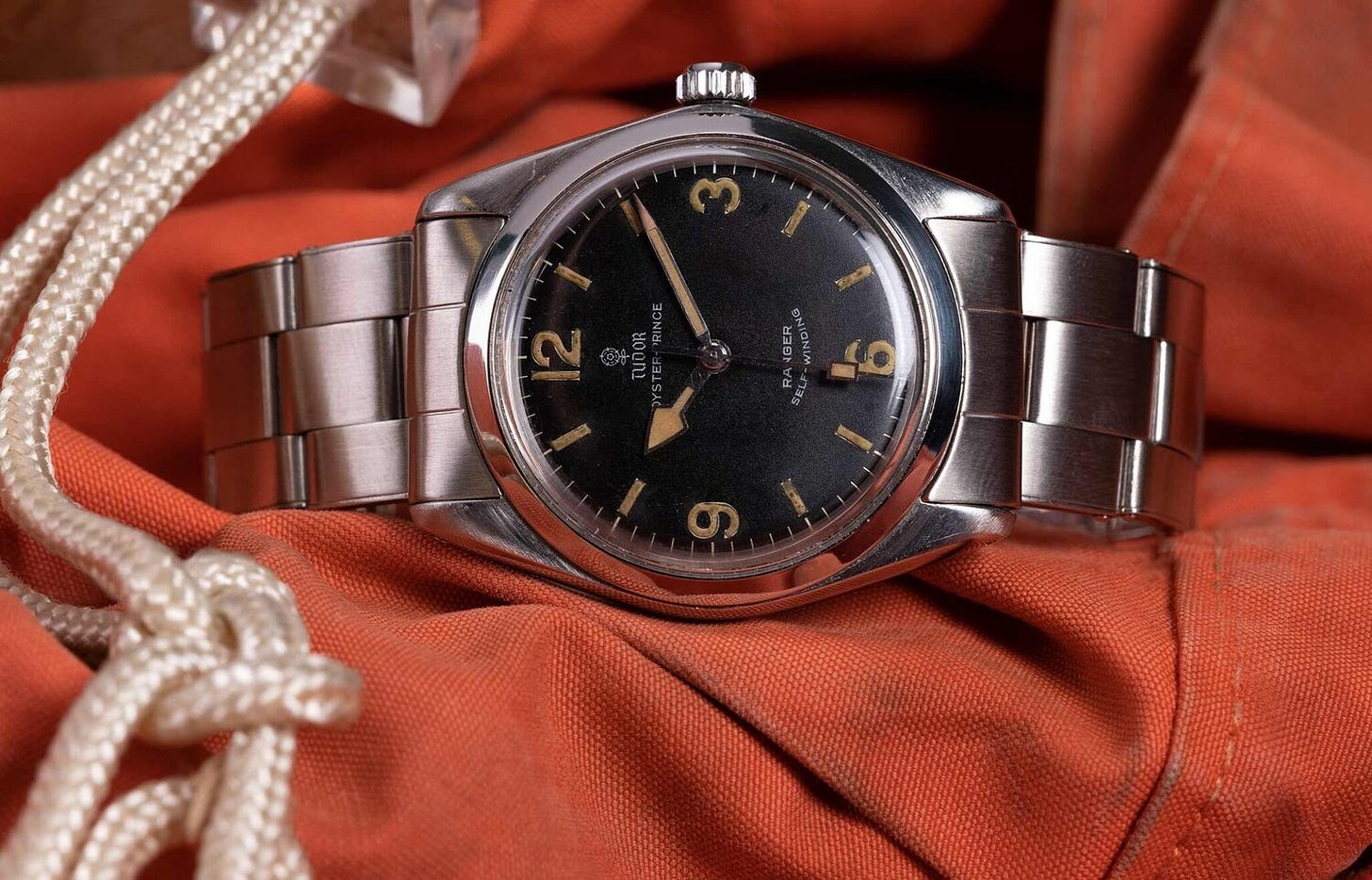
Ranger Ref. 7995 | Credit: Tudor Watch
Eventually, Tudor replaced the Reference 7965 with the Reference 7995, the reference which Tudor drew inspiration from for its 2014 release of the Heritage Ranger.
It is similar in most respects to the earlier 7965: an automatic, no-date reference, with the same dial text. However, it saw a longer production run, spanning from at least 1966 through 1969. Early examples of the Reference 7995 utilize a rose, with later examples featuring the shield logo. Additionally, early examples can be found with a flared minute hand, which eventually makes way for the pencil hand. However, it likely would not be correct for an example to have both a Shield logo and a flared minute hand (indeed, I have not seen an original shield logo Ranger with a flared minute hand).
Like with other references powered by an automatic caliber, the self-winding rotor is engraved Tudor Auto-Prince, and the movement number, in this instance, 2483, is engraved under the balance wheel.
Ranger Reference 7996
AUTOMATIC, DATE
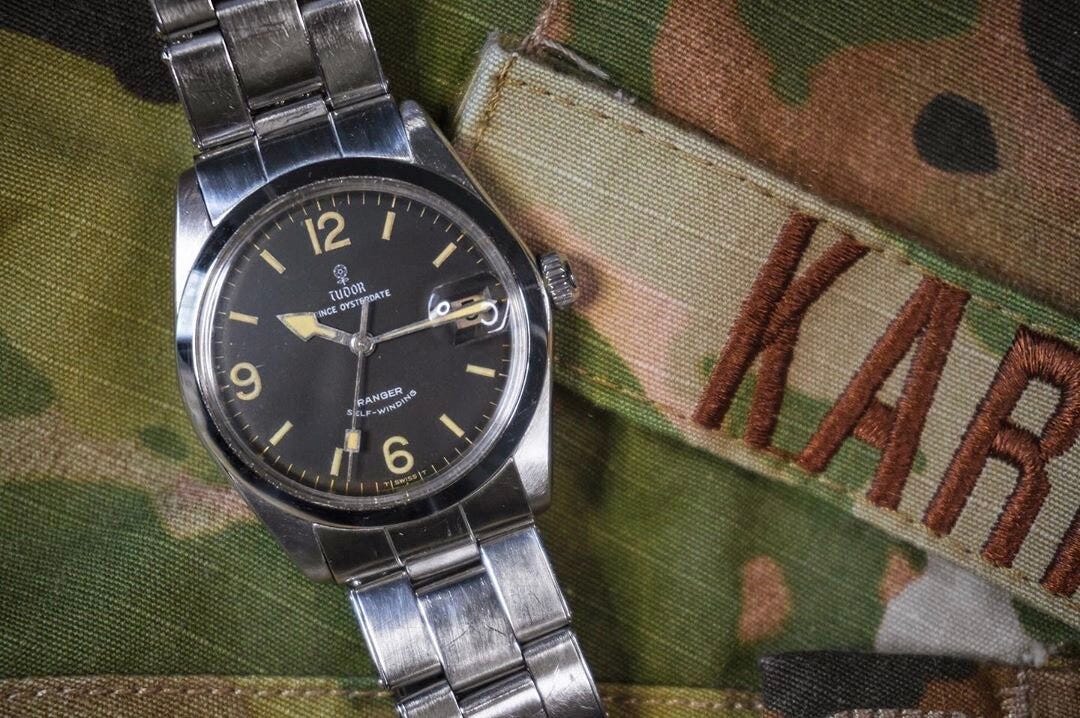
Ranger Ref. 7996 with Mk 1 flared minute hand | Photo courtesy of @mkrlx
Alongside the automatic, no-date references, Tudor also introduced the Reference 7996 and Reference 7966, the date complication versions of the model. The original crystal will feature a cyclops date at 3 o’clock, but in many other respects the references look similar to the no-date Rangers of the era. The movement is an ETA 2484, a non-quickset caliber, again engraved Tudor Auto Prince on the rotor. Generally, the Reference 7996 looks to sit earlier chronologically than the Reference 7966.
The Reference 7996 also saw a shorter production run, likely only for the years 1965-1966. This means it would have been largely produced alongside the Reference 7965; indeed, it features many of the same characteristics as that no-date reference. It has a rose logo, with early examples featuring the Mark 1 flared minute hand, and later examples moving to the pencil hand. Under the rose logo is the print Prince Oysterdate (note that Oysterdate is one word), and at 6 o’clock the smiling Self-Winding text again features under Ranger.
In general, date models of the Ranger are more common than the no-date models: presumably, consumers of the time appreciated the practicality of the additional complication. That said, the Reference 7996 is an early reference that remains quite rare.
Early examples of the Oysterdate Ranger feature a “roulette” date wheel with even numbers in red and odd numbers in black. At some point in the mid- to late-1960s, Tudor transitioned to a date disc with all-black numerals.
Ranger Reference 7966
AUTOMATIC, DATE
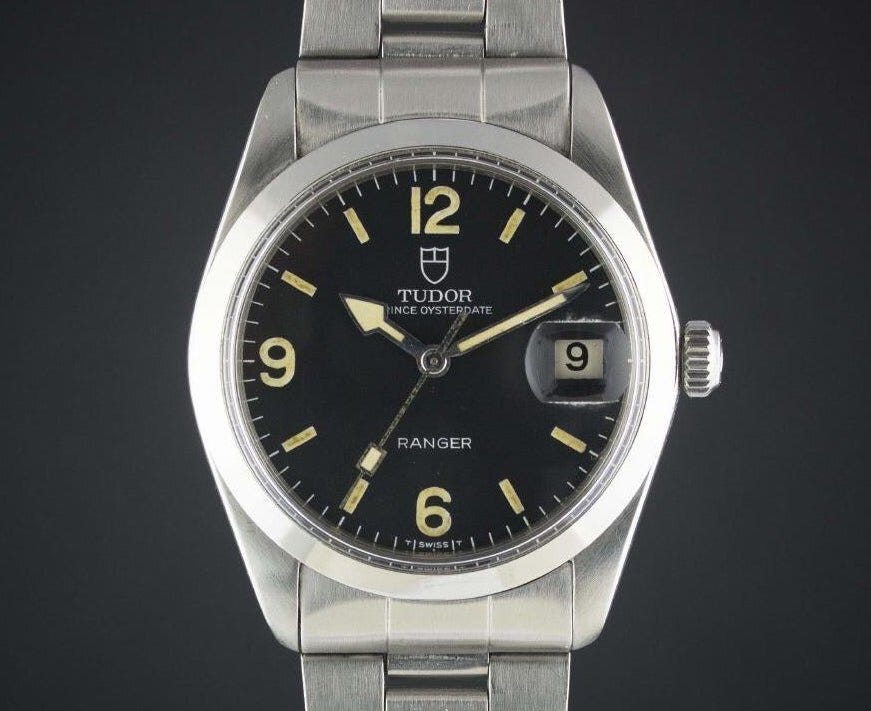
Credit: Watches of Knightsbridge
The Reference 7966 seems to have had a particularly long production run, from about 1966 through 1969. But, unlike with previous examples we’ve seen, the appearance of this reference remains remarkably similar throughout its production, showing some evolution from the earlier references. Examples feature a shield logo and pencil minute hand, Tudor having fully transitioned away from the rose logo and flared minute hands we see in early examples.
Additionally, the Self-Winding text at 6 o’clock is now gone, leaving just Ranger in a slightly larger font than is seen in previous references, also transitioning to sans-serif.
Ranger Reference 9050
AUTOMATIC, DATE
Like the Reference 7966, the Reference 9050 had a relatively long production run, with examples being found from about 1969 through 1975. Together, the Reference 7966 and 9050 seem to be the most commonly found Ranger references (which is not to say they are easy to find). The Reference 9050 is, in all material respects, the same as the earlier Reference 7966: shield logo above the Prince Oysterdate print, ETA caliber 2484, larger Ranger print at 6 o’clock and a pencil minute hand.
Ranger Reference 7984
MANUAL, NO DATE
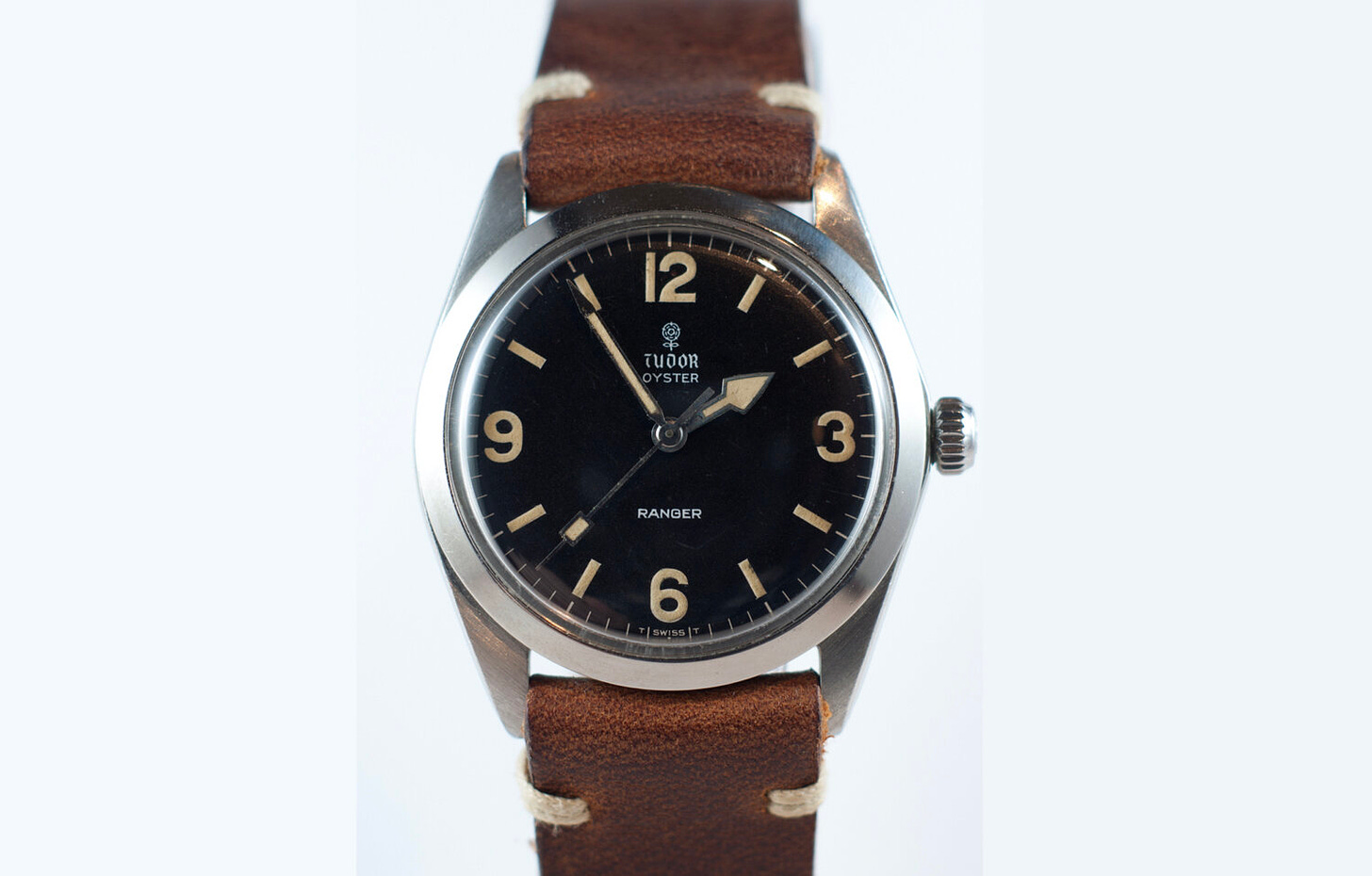
The automatic Oyster-Prince references make up the bulk of the Tudor Ranger line throughout the Early Series. However, there are also a few rare references that instead utilize manual wind calibers. The first of these to feature — and perhaps the most rare — is the Reference 7984. Examples of this reference with serial numbers dating to the latter half of the 1960s can be found, all featuring Rose logos. Underneath the logo sits only the word Oyster, indicative of the manual wind ETA movement inside.
Due to its rarity and the austere dial, the manual wind rose Ranger is particularly sought after by collectors, rarely seen offered publicly.
Ranger Reference 7991
MANUAL, NO DATE
Coming after the Reference 7984 chronologically, the Reference 7991 is another example of a manual wind Ranger. Examples of this reference feature the shield logo above the Oyster print, again indicating later production years than examples of the rose Ranger 7984. The Reference 7991 is powered by an ETA caliber 2422, with Tudor and 17 Rubies Swiss Made engraved across the bridge.
Tudor Ranger: Late Series
By the 1980s, Tudor finally gave the Ranger model its own set of case reference numbers, distinct from the Oyster and Oyster-Prince lines. This makes it easier for collectors to evaluate the originality of this Late Series of references. However, even with production spanning much of the 1980s, the 90000 series of Rangers still proves to be a rare find.
For this Late Series, the Ranger largely stays true to the aesthetics of the Early Series: the stainless steel case remains 34mm, the instantly identifiable Explorer dial remains, and ETA movements continue to provide its beating heart. However, you will notice that the Arabic numerals tend to have a slightly “puffier” appearance — Tudor didn’t shy away from the application of lume during these years. Additionally, the text printed on the dials is updated slightly.
While Tudor of the pre-1980s is known for using Rolex-signed cases, crowns and bracelets, by the 1980s this begins to change. As such, you’ll find these Late Series Rangers with Tudor-signed clasps on their Oyster-style bracelets. However, the crown will still be signed with the Rolex coronet.
For this Late Series, Tudor offered both a manual wind and an automatic model, each with a few distinct qualities. Examples of both references can be found with serial numbers dating throughout most of the 1980s, up until 1988, when Tudor retired the Ranger model (at least in its traditional form).
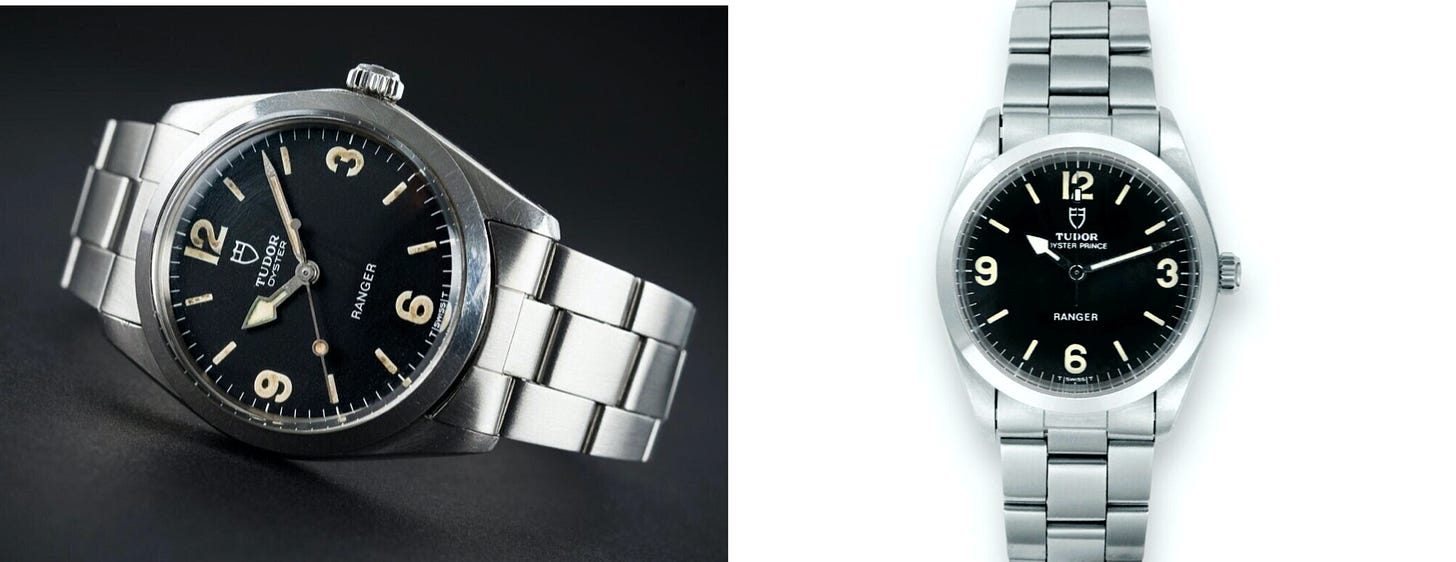
Credit: (L) Ref. 90020, Watches of Knightsbridge; (R) Ref. 90220, Antiquorum
Ranger Reference 90020
MANUAL, NO DATE
The Ranger Reference 90020 features a manual wind movement. As such, it has Oyster only printed below the shield logo, again leaving the dial minimal and functional. The sans-serif Ranger printed at 6 o’clock largely resembles that seen in later examples of the Reference 7966 and 9050. The Reference 90020 is powered by an ETA caliber 2750, which brings a hacking seconds function to the manual wind Ranger.
Ranger Reference 90220
AUTOMATIC, NO DATE
Alongside the manual wind version, Tudor also offered the Reference 90220, powered by an automatic caliber 2776. At 12 o’clock, Oyster Prince is printed in sans-serif, this time two words (as opposed to the hyphenated version in the Early Series). Besides the automatic movement and differing text to indicate such, the Reference 90220 is largely similar to its manual wind companion of the Late Series.
“Grail” Rangers
For some, any rose Ranger (especially of the no-date variety) is a grail-worthy watch that one can spend years searching for. As mentioned, the manual-wind rose Rangers are more rare, and considered particularly desirable. No more than a handful have surfaced in the collecting community over the years. Aesthetically, some prefer the automatic rose Rangers because of the smiling Self Winding text at 6 o’clock.
Separately, a couple examples of a dial variation featuring Arabic numerals at every hour marker (i.e. larger numerals at 3-6-9-12, with slightly smaller numbers at the intervening markers) have surfaced over the years. These dials have appeared in the Reference 7996, and are thought to be rare test or prototypes sold into the Canadian market.
Advertising and anomalies of the Ranger
As with other vintage watches, print advertisements from the era offer some additional clues regarding the Ranger. That said, advertisements for the Ranger must be taken with a grain of salt, as the model was a configuration assembled within multiple references, with many transitional elements that make it difficult to pin down its qualities at any particular point in time.
One particular ad (below) illustrates a Reference 7995 alongside a Reference 7966; the ad seems innocuous until one notices that the Reference 7995 features stick hands, a true anomaly for the Ranger, given that the distinctive shovel hour hand is one of the model’s most identifiable traits.
For all the reasons mentioned throughout this article, it is completely possible that there exist correct, original examples of Tudor Rangers with these stick hands. Indeed, Antiquorum recently sold such an example, even specifying the hands as original in its condition report. That said, I’d warn extreme caution for any Ranger with stick hands; almost all examples feature the shovel minute hand, and spare stick hands are much more easily found by unscrupulous parties.

(L) A Ranger ad from the 1970s, with an odd example featuring stick hands; (R) an example featuring stick hands, sold by Antiquorum | Ad photo courtesy of @369_mafia
Collecting the Tudor Ranger

For such an innocent-looking watch, the Tudor Ranger can be incredibly difficult to collect. Its rarity makes it difficult to catalog, also making it challenging to find references against which to compare another example. Additionally, the number of transitional elements — logos, hands, fonts — makes it difficult to understand what might be correct for any given production date or serial number range. As such, the cataloging presented here is meant not to be completely definitive, but as a framework or guideline as to what is generally accepted to be correct by collectors.
Search “Tudor Ranger” today — or any day — and you’re quickly presented with more fakes and frankenwatches than perhaps any watch in the Tudor-Rolex family. The information presented here should help you to quickly eliminate most of those as potentially legitimate examples: the reference number will not align with the correct date/no-date configuration, a flared minute hand will appear in a later serial number, the dial text will simply be incorrect, and so on.
Frustrated both by the continued proliferation of fakes or frankenwatches on the market, and the lack of a comprehensive source of information on the Tudor Ranger, I began cataloging sales and discussing the model with collectors. Most frustratingly, I’d continue to see — what I now recognize as — completely faked watches commanding prices that they had no right to from buyers who just didn’t know any better.
Of course, the most obvious comparison for the Ranger is to the Rolex Explorer. But while the Explorer had just one reference, the 1016, during the entire production of the Early Series and Late Series Rangers, the Ranger had at least nine correct references. This makes the Ranger more difficult, but also more fun, to hunt and collect. Still, the Ranger remains much rarer than the Explorer. Despite this rarity (or perhaps, for the reasons discussed here, because of it), the Ranger can still be had for a fraction of the price of a Rolex Explorer.
To me, Tudor has always been perhaps the most fascinating of vintage watch stories. Yes, the connection with Rolex — and the guarantee that you’ve got a solid watch — is important, but that sells the brand short. Unmoored by the expectations of the Coronet (heavy hangs the crown), Tudor has always been able to experiment more freely, coming up with daring, often outlandish watches and designs. It almost feels subversive to Rolex: the little brother that gets away with mischief because mom and pop Wilsdorf have neglected to keep a stern eye over their youngest child. Nowhere is this more evident than with the Tudor Ranger.
Reference Table

*This table is based on observed examples. Because of the nature of the Tudor Ranger, it is possible that a correct example might fall outside these parameters.
Acknowledgment: Thank you to the many collectors who contributed their knowledge, watches, and photographs to this article. Additionally, almost no comprehensive cataloging of a vintage watch is possible without the help of Eric Wind; this article is no exception.
—
For all the latest, head to rescapement.com and follow us on Instagram.


